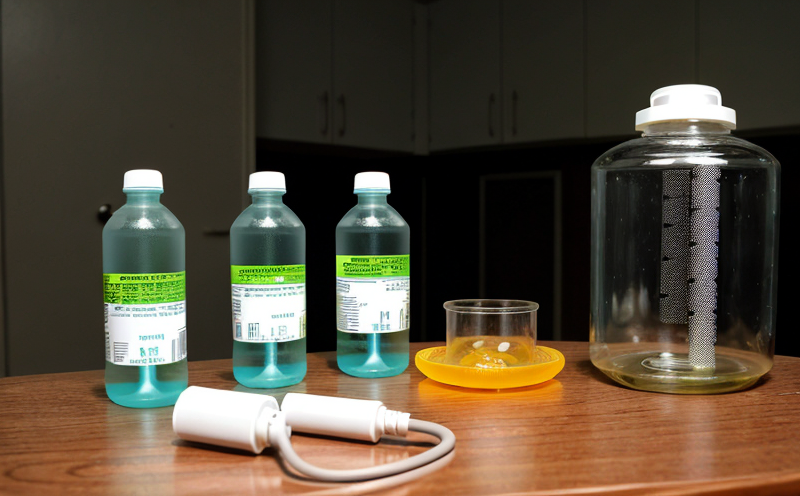EPA 932 Radium Isotopes Determination Test in Water
The EPA Method 932 is a critical analytical technique used to determine radium isotopes (Ra-226 and Ra-228) in water samples. This method ensures compliance with federal drinking water standards set by the Environmental Protection Agency, particularly under the Safe Drinking Water Act.
Radium isotopes are naturally occurring radioactive elements that pose significant health risks when present at elevated levels in drinking water. EPA Method 932 provides a robust framework for quantifying these radium isotopes, thereby ensuring public safety and environmental protection.
The test involves several key steps: sample collection, transport, and preservation; filtration of the water sample to remove particulate matter; digestion of the filtered sample using nitric acid; and finally, the determination of radium isotopes through a combination of chemical separation techniques and radiometric counting. The method is designed to yield accurate results that can be used for regulatory purposes.
Accurate quantification of radium isotopes in water is essential for meeting drinking water standards outlined by the EPA. These standards are set to protect public health, ensuring that levels of these radioisotopes do not exceed safe limits. By adhering to EPA Method 932, laboratories can provide reliable data that helps utilities and regulators make informed decisions regarding water quality.
The method also allows for the identification of potential sources of radium in water systems, which is crucial for implementing effective mitigation strategies. This includes assessing natural geological sources as well as anthropogenic inputs such as industrial discharges or agricultural runoff.
Given its importance in ensuring public health and compliance with regulatory requirements, EPA Method 932 has been widely adopted by laboratories serving the water utilities sector. The method's robustness and reliability make it a cornerstone of water quality testing programs across the United States.
The analytical process described in EPA Method 932 is designed to minimize biases and ensure accurate results. This includes careful sample handling, precise chemical digestion procedures, and meticulous radiometric counting techniques. The method specifies the use of specific reagents and equipment to achieve consistent and repeatable results.
Compliance with this method not only ensures that water utilities meet legal requirements but also enhances public confidence in the safety of drinking water supplies. By adhering strictly to EPA Method 932, laboratories play a vital role in safeguarding public health and maintaining environmental integrity.
The accuracy and reliability of results obtained through this method are paramount for regulatory compliance and ensuring safe drinking water. The method's stringent protocols ensure that the data generated is trustworthy and can be relied upon by stakeholders involved in water quality management.
| Step | Description |
|---|---|
| Sample Collection | Collect water samples from representative locations in the distribution system. |
| Filtration | Filtrate the collected sample to remove particulate matter using a 0.45 µm filter. |
| Digestion | Digest the filtered sample with nitric acid for complete dissolution of radium isotopes. |
| Final Determination | Determine radium isotopes using radiometric counting techniques. |
Industry Applications
EPA Method 932 finds extensive application in the water and wastewater testing sector, particularly for drinking water utilities. It is also used by research institutions and environmental agencies to monitor radium levels in various water sources.
| Application | Description |
|---|---|
| Drinking Water Utilities | Determine compliance with EPA standards for radium in drinking water. |
| Water Quality Research | Conduct research to understand the sources and behavior of radium isotopes in water systems. |
| Agricultural Runoff Monitoring | Evaluate potential contamination from agricultural activities affecting local water bodies. |
| Industrial Wastewater Treatment | Assess the effectiveness of wastewater treatment processes in removing radium isotopes. |
| Environmental Impact Assessments | Conduct assessments to determine environmental impacts of activities involving radium release into water systems. |
Quality and Reliability Assurance
The quality assurance (QA) and quality control (QC) protocols in EPA Method 932 are integral to maintaining the accuracy and reliability of test results. QA involves establishing and implementing procedures that ensure consistent and reliable performance, while QC focuses on monitoring this consistency.
Key aspects of QA include:
- Regular calibration of analytical instruments
- Precision and accuracy checks using certified reference materials (CRMs)
- Data validation and verification processes
QC measures ensure that each sample is handled according to specified protocols, minimizing variability. This includes:
- Reproducibility checks between analysts
- Duplicate testing of samples to assess precision
- Inclusion of quality control (QC) samples in every batch of tests
The use of CRMs allows for the standardization of test conditions, ensuring that results are comparable across different laboratories. This is particularly important given the critical nature of radium isotopes testing.
International Acceptance and Recognition
EPA Method 932 has gained international recognition for its reliability and accuracy in determining radium isotopes. Many countries have adopted similar methods or recognize EPA results as acceptable for regulatory purposes.
The method aligns with international standards such as ISO/IEC 17025, which sets requirements for the competence of testing and calibration laboratories. By adhering to these standards, laboratories performing EPA Method 932 can ensure their methods are recognized globally.
Recognitions from organizations like the World Health Organization (WHO) further validate its importance in global water quality management efforts. The method's widespread use by international agencies underscores its significance in ensuring safe drinking water worldwide.





